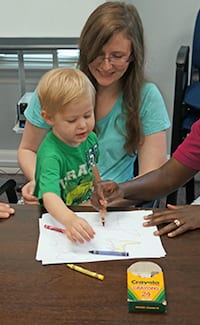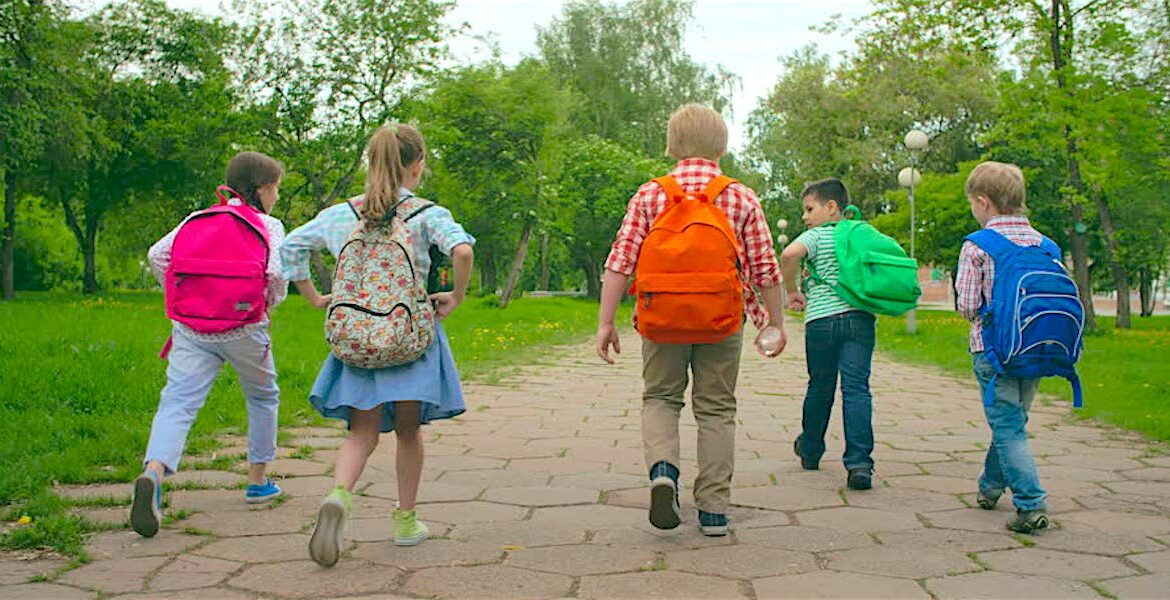Table of Contents
We’re facing a crisis in parental engagement as EdTech complicates educationby Steve Clark
 It’s just us students in the middle car as we race to learn as much, and as fast, as we can. The teachers are in the first car, leading the “education caravan” because they’re the only ones who know where we are going. Our parents are in the third car, trailing – trying to keep up in the old minivan. We keep looking back to make sure they are with us, but really, we have to focus on the teachers’ car in front of us. It’s been pounded into us that if we fall behind, we’ll get lost and never reach our life goals.
It’s just us students in the middle car as we race to learn as much, and as fast, as we can. The teachers are in the first car, leading the “education caravan” because they’re the only ones who know where we are going. Our parents are in the third car, trailing – trying to keep up in the old minivan. We keep looking back to make sure they are with us, but really, we have to focus on the teachers’ car in front of us. It’s been pounded into us that if we fall behind, we’ll get lost and never reach our life goals.
We are going even faster now. We round a few curves. Take a sharp right turn. And, looking back, we see no one behind us. We keep glancing back hoping Mom and Dad will catch up, but after a few more high-speed turns we know we have left them too far behind. They will never catch up now. Our only option is to floor it and not lose sight of the teachers. On the one hand we are learning to drive very fast, but on the other hand… we will be alone when we get wherever we are going.
Only a few decades ago, before GPS and cell phones, a bunch of people in three cars on their way to a movie or an away game across town may have had only one driver who knew the way. Everyone else had to rely on that person to find the way – while keeping the caravan together. Just because they knew something the rest did not, they became the trusted leader. As EdTech creates educational acceleration, teachers are the only ones who know where the caravan is going. They are the ones driving the front car; in charge of what the students will learn and what technologies will be used in the classroom. As it should be, their focus is locked on the students. But with so many changes happening so often, and including sophisticated technologies that are changing instructional methods and strategies, we cannot afford for parents to be left behind. The human cost is too great.
Parent Engagement Then and Now
Parents have always had a role in support of their child’s education. What was once about figuring out and explaining exponents and conjugated verbs, is now about rebooting tablets, and resetting passwords. As education changes from the analog and manual, to massive use of digital learning platforms, tools, and processes, parents are still needed, maybe more than ever. With rapid changes come gaps and cracks where people can fall in and become lost, just like when that last car in the caravan rounds a curve, comes to a four-way intersection and sees no one around. Being lost and left behind is a lousy experience. But where children and families are involved, it is worse than that. It becomes dangerous.
Schools have finally accepted the advantages of educational technologies (EdTech) and seem to find more and more use for them in the classrooms. This is a good thing. In order to have a chance of competing globally, developing and delivering a qualified workforce into a constantly evolving employment market, schools must break free from traditional schooling and brave their way through huge changes. Not only has education itself accelerated, but we are seeing the process of trying, adopting, implementing, learning, and mastering these new advantages also accelerating. What we are seeing is a whirlwind revolution of sorts as teachers attend pro-dev workshops every summer for some new tool, app, robot, AI function, digital platform, assessment programming, or group-think facilitator that just became available.
To their credit, the hungry minds of youth are eating up these changes. These new ways of learning are as exciting for the students as getting a new smartphone or buying a new car is for their folks. Shiny, new, and intriguing – what’s not to like? New EdTech comes with many features, gadgets, and discoveries to explore and try out. It’s exciting. But, where is the inclusion of parents? How are they supposed to be valued partners in the process? Not only despite the changes, but because of them, parents and children need to travel the learning journey together and maintain a cohesive relationship.
The Dangers Are Real
School has always had a certain amount of scariness to it for kids. Being away from the safety of home. Other kids who do things differently. New teachers each year. Higher and higher expectations. Report cards! Rules. Then there are recess games, phys. ed. failures, school bus trips, bullies, class presentations, late homework, being laughed at, and many other opportunities to feel awkward, embarrassed, alone, and scared. Middle school puberty is horrible for anyone, and then there’s high school. Peer pressures, dating, sexuality, teen pregnancy, drinking and drugs, learning to drive, fights, part-time jobs, and facing post-grad choices like college, enlisting or getting a job.
 Today’s kids have it harder. There is more pressure to succeed from parents and teachers than ever before. There are societal pressures around fashion, entertainment, social media, and what college you got into. Combining the Internet with smartphones brings about cyber-bullying, pornography, gambling, scams, twisted and evil content, hyper-violent video immersion games, malware, and identity theft. Then there are predators and stalkers, gangs, haters, sexting, FOMO, and increased isolation. These are not just scary things but are real dangers that must be faced and figured out. In students’ quest for independence, missteps are common and come with lasting consequences. School violence, shootings, depression, and suicide are always in the back of their minds.
Today’s kids have it harder. There is more pressure to succeed from parents and teachers than ever before. There are societal pressures around fashion, entertainment, social media, and what college you got into. Combining the Internet with smartphones brings about cyber-bullying, pornography, gambling, scams, twisted and evil content, hyper-violent video immersion games, malware, and identity theft. Then there are predators and stalkers, gangs, haters, sexting, FOMO, and increased isolation. These are not just scary things but are real dangers that must be faced and figured out. In students’ quest for independence, missteps are common and come with lasting consequences. School violence, shootings, depression, and suicide are always in the back of their minds.
The point here isn’t that kids shouldn’t have access to the Internet. The point is that kids shouldn’t be left to make sense out of all this by themselves. Today’s students need parents more than ever. Parents can warn, teach, mentor, and guide their kids through much of this jungle, and when a mistake or failure happens, they can help the child recover, heal, and get back in the game. Having a trusted, caring, willing parent in their corner can mean the difference between global champion or career criminal, or victim.
Educational Technology – Friend or Foe?
With each EdTech innovation, parents are left behind more and more. And it’s not just the apps, tools, devices, digital platforms, and protocols that change each year. The use of EdTech is also changing classroom instruction. First graders, and younger, are learning how to code! We now see in-class strategies using:
- Critical thinking
- Abstractive decision making
- Collaborative techniques
- Computational thinking
- Artificial intelligence
- The science of learning
- Global learning
- Digital portfolios
- Individualized learning tracks and profiles
- The use of virtual and augmented realities
- Digital citizenship
- Student-centered learning
But, when kids come home from their intense workday, they still want to know they can count on Mom and Dad. At first, it’s enough to get hugs, meals, clothes, band-aids, and transport. At the rate kids are learning these days they soon know things their parents don’t. They also know how to get in, operate, save work, and close various technology systems their parents have never seen. With all there is for a parent to keep up within their own responsibilities – and having to also keep up with their child’s rapidly evolving mind, changes to instructional reasoning, and myriad EdTech systems, tools, protocols, and outcomes – the opportunity for parent and child to grow apart is enormous. This easily leads to some doubts by the child – maybe they don’t know everything, maybe they don’t know what school is like for me. And suddenly, the child believes they are alone in this institution. When kids start believing their parents are irrelevant, it can lead to real trouble. And one more thing. Once the cohesive parent/child partnership is eroded and dissolved, it usually remains broken, causing lifelong effects.
 Technology, in and of itself, is not a good or bad thing. It is not a force or influence on people. It is the way we use and interact with technology that determines our end experience of it. Since teachers control the classroom and are the primary implementers and managers of these great educational changes, then it is also their responsibility to not lose anyone off the back of the caravan. This means they need to take action to deliberately involve parents, give parents a role, and allow children to see their parents as relevant parts of their learning experience. Teachers need to ask, or even demand, that districts and EdTech system developers find a way to include parents.
Technology, in and of itself, is not a good or bad thing. It is not a force or influence on people. It is the way we use and interact with technology that determines our end experience of it. Since teachers control the classroom and are the primary implementers and managers of these great educational changes, then it is also their responsibility to not lose anyone off the back of the caravan. This means they need to take action to deliberately involve parents, give parents a role, and allow children to see their parents as relevant parts of their learning experience. Teachers need to ask, or even demand, that districts and EdTech system developers find a way to include parents.
What We Can Do
If we do nothing, we are dooming our children to face scary and real dangers, life issues, and lasting decisions without the partner, leader, counselor, and advocate they truly need. At what point will a young child look in the rearview mirror and have to choose between going it alone or waiting for Mom and Dad to catch up? Should children really be forced to face such a choice when they are already facing so much?
What it comes down to is chosen actions. Do we all continue to take what EdTech companies give and just be humbly thankful? Or, as parents fall further and further behind and the wholeness of children is threatened, do we recognize the opportunity to leverage EdTech capabilities to actually engage parents? Is what we have good enough? No. I don’t think so. And you know they are going to improve on it, right? So why not think strategically and ask them to improve on it in a way that will help parents keep up?
The need for improved strategies isn’t just about education. The question is whether those in the lead car see the need to do something about it. It is up to the leaders, and much depends on them making smart choices. District leaders and teachers must recognize the need for new EdTech strategies that deliberately include parents in their children’s EdTech experiences without requiring parents to become experts.
EdTech, across the board, is already lowering the barriers to new user adoption. Is it so far-fetched to believe EdTech could somehow “virtually” place parents in the front car so they could look out the back and watch their children trying to learn so much, so fast? If EdTech and teachers can figure out how to include parents, the K-12 years may actually end up creating mutual understanding, participation, dialogue, and cohesiveness within families, instead of isolation.
Author
 Steve Clark has more than eighteen years of experience as a highly-engaged parent of students in public schools. He is founder and president of Leading to Your Success, an organizational learning and technology consultancy, and in 2017 launched its subsidiary, Parent Engagement Solutions. You can follow Steve Clark on Twitter.
Steve Clark has more than eighteen years of experience as a highly-engaged parent of students in public schools. He is founder and president of Leading to Your Success, an organizational learning and technology consultancy, and in 2017 launched its subsidiary, Parent Engagement Solutions. You can follow Steve Clark on Twitter.
Further Reading
- Tech Edvocate – 12 Questions Parents Have About EdTech
- Forbes – This Edtech Startup Wants Your Kids To Be Social Change Agents
- Ed Tech Team – Top 10 Ways to Involve Parents by Using EdTech


